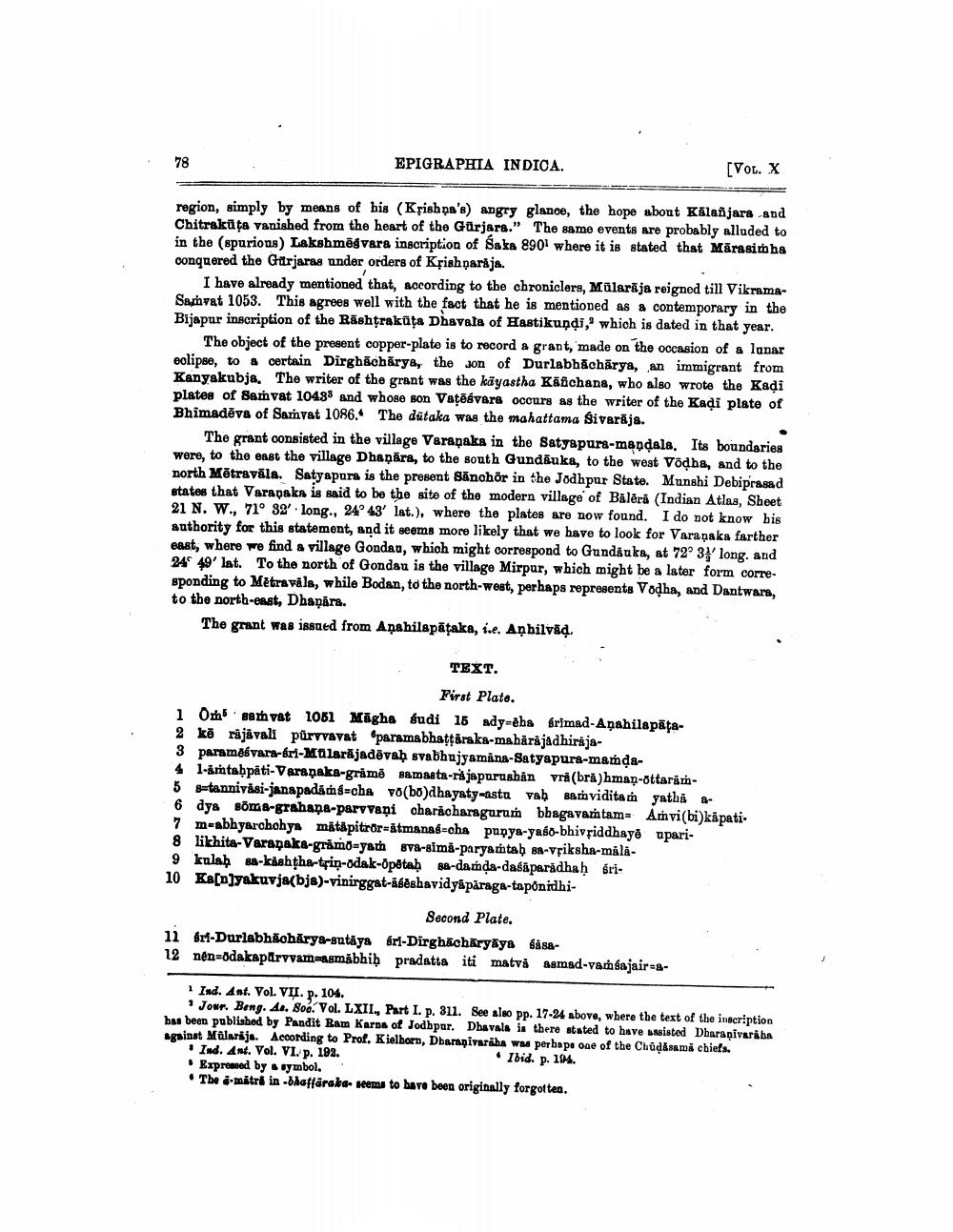________________
EPIGRAPHIA INDICA.
[Vol. X
region, simply by means of his (Kfish a's) angry glance, the hope about Kālaħjara and Chitrakūta vanished from the heart of the Gurjara." The same events are probably alluded to in the (spurions) Lakshmēgvara inscription of Saka 8901 where it is stated that Mārasimha conquered the Gurjaras under orders of Kpish pardja.
I have already mentioned that, according to the chroniclera, Mülarija reigned till VikramaSamyat 1053. This agrees well with the fact that he is mentioned as a contemporary in the Bijapur inscription of the Rashtrakūta Dhavals of Hastikundi,' which is dated in that year.
The object of the prosent copper-plate is to record a grant, 'made on the occasion of a lunar eclipse, to certain Dirghicharya, the jon of Durlabhłcharya, an immigrant from Kanyakubja. The writer of the grant was the kāyastha Kanchana, who also wrote the Kadi plates of Samvat 10488 and whose son Vatēsvara occurs as the writer of the Kadi plate of Bhimadēva of Sarnyat 1086. The dutaka was the mahattama Śivarēja.
The grant consisted in the village Veranaka in the Satyapura-mandala. Its boundaries were, to the east the village Dhaņära, to the south Gundāuka, to the west Vödha, and to the north Mētravāla. Satyapura is the present Sanchor in the Jodhpur State. Munshi Debiprasad states that Varapaka is said to be the site of the modern village of Bālēră (Indian Atlas, Sheet 21 N. W., 71° 32' long., 24° 43' lat.), where the plates are now found. I do not know his authority for this statement, and it seems more likely that we have to look for Varanaka farther Bast, where we find a village Gondan, which might correspond to Gundauka, at 72° 3y long. and 24° 49' lat. To the north of Gondau is the village Mirpur, which might be a later form corresponding to Mētravals, while Bodan, to the north-west, perhaps represents Vodha, and Dantwara, to the north-east, Dhanára.
The grant was issaed from Anahilapātaka, sie. Aņbilväd.
TEXT.
First Plato. 1 Om samvat 1061 Māgha sudi 16 ady-eba Srimad-Anahilapāta2 kö räjävali püryvavat paramabhattaraka-maharajadhiraja3 paramosvararl-Mailarājadēvah svabhujyamina-Satyapura-manda4 l-amtaḥpäti-Varapaka-gråmě samasta-rajapurushanvråbrå)hman-ottaram5 setannivåsi-janapadámg=che vo(bo)dhayaty-astu vab samviditam yatha &6 dya som s-grahaņa-parvvaņi charåcharagurum bhagavam tam= Anvi(bi)kapati7 m-abhyarchohya matapitror=stmanag-cha punya-yaso-bhivsiddhayo upari8 likhita-Varanaka-gråm-yath BV&-simä-paryattah sa-vriksha-mala9 kulah sa-kishtha trin-odak-opēta) 88-damda-dasaparidhaḥ sri10 Ka[n]yakuvja(hja)-vinirggat-abeshavidyāpāraga-tapônidhi
Second Plate. 11 ért-Durlabhłohārya-sutaya Sri-Dirghachäryäys sisa12 nen=Odakaparvvamaasmäbhiḥ pradatta iti matvs Asmad-vamajair=8
Ind. Ant. Vol. VII. p. 104.
* Jour. Beng. 41. 806. Vol. LXII., Part I. p. 311. See also pp. 17-24 above, where the text of the inscription bas been published by Pandit Ram Karna of Jodhpur, Dhavals is there stated to have assisted Dharapivarába against Malerije. According to Prof. Kielborn, Dbaraziyariha was perhaps one of the Chudasama obiefs. • Ind. Ant. Vol. VI. p. 192.
• Ibid. p. 1M. Exprewed by symbol. • The a-mitri in-bhattaraka- seems to have been originally forgotten.




